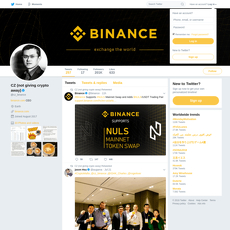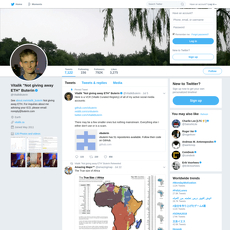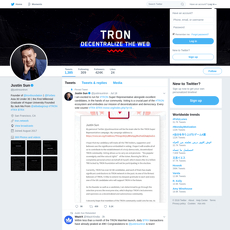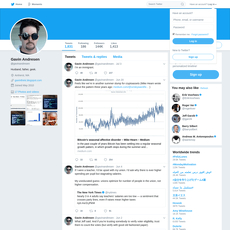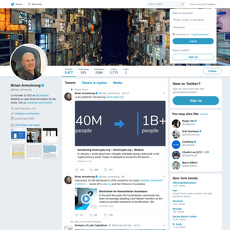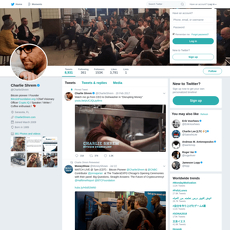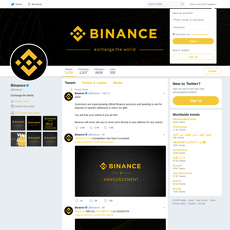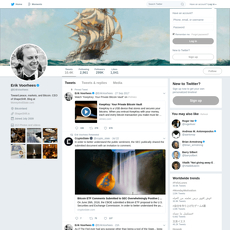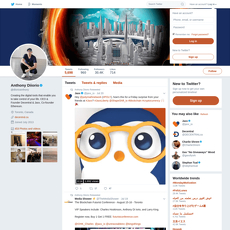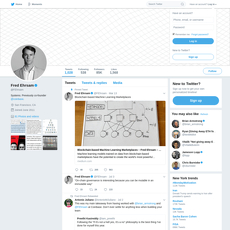Linda Xie Review
Linda Xie
twitter.com
Linda Xie Review Guide: Everything You Need to Know + FAQ
Who should you actually follow on crypto Twitter without wasting hours—and how do you separate real insight from loud opinions?
If you’ve ever asked that, you’re in the right spot. I’m going to show you why I keep an eye on Linda Xie, what she’s great at, and how to squeeze real value out of her feed without getting lost in noise.
By the end of this guide, you’ll know exactly what to expect from @ljxie, how I evaluate her signal, simple steps to use her insights, and a fast FAQ to clear up common questions.
The problem most people hit on crypto Twitter
It’s not the lack of information—it’s the flood of it. Your feed turns into a firehose: hot takes, memes, vague threads, and zero context on incentives. You scroll, you skim, and you learn almost nothing.
Quick reality check: Research shows misinformation spreads faster than truth on social platforms. One landmark study in Science found false news reaches more people and travels quicker than verified stories. That’s exactly why a trusted, slow-and-steady signal matters.
Source: Science (MIT study): The spread of true and false news online
On top of that, most feeds don’t disclose biases, which makes it hard to know what’s objective, what’s sponsored, and what’s just wishful thinking. And because we skim more than we read online, important nuance gets lost.
Nielsen Norman Group has studied this for years: people scan, not read. So a feed that’s calm, clear, and context-rich is a real advantage.
What I’ll solve for you here
- What Linda actually posts (not just hype)
- Where her strengths are—think governance, regulation, NFTs, DeFi building blocks
- How to vet takeaways so you don’t fall for confident but shaky claims
- How I personally use her content to stay sharp without losing time
“Don’t chase noise. Curate a few high-trust voices, add context, verify, and move on.” — a simple rule I follow for every crypto account, including @ljxie.
Who this guide is for
- Investors who want researched frameworks over price calls
- Builders who care about product reality, security, governance, and policy
- Curious learners who prefer clear explainers, original thinking, and high-signal links
If you want nonstop pumps, this isn’t it. If you want long-game crypto insight you can actually use, keep reading.
What you’ll learn in a few minutes
- Background snapshot: why her operator-and-investor lens matters
- Topics she’s best at: regulation/policy, governance, NFTs/crypto art, DeFi fundamentals
- How often she posts: steady, intentional, and not spammy
- Fast fact-check habits: quick ways to verify before you act
- A simple workflow: turn her tweets into learning and action without getting sucked into your feed
- Quick FAQ: common questions people ask about @ljxie—answered
I’ll also flag the guardrails I use to avoid bias traps and time sinks, so you can focus on the insights that compound.
Ready to get a clean, useful picture before you commit your attention? Great—next up: who is Linda Xie, what’s her background, and why should you trust her point of view in the first place?
Who is Linda Xie? Background and credibility
If I had to name one crypto voice that blends operator grit with investor patience, it’s Linda Xie. She co-founded the crypto fund Scalar Capital after years at Coinbase, and that split background matters: she understands how products actually get used and how early-stage teams turn ideas into durable value.
“Clarity beats noise. That’s the edge most people ignore.”
That’s the vibe I get when I track her work—clear, calm, and focused on fundamentals.
Scalar Capital: investing lens
Scalar Capital is where Linda’s long-term thinking shows. The fund backs early-stage crypto projects that aim for real utility, not just clever tokenomics. What stands out to me is how her lens prioritizes:
- Teams with a plan for users — not just protocol elegance, but how the thing gets used in the wild.
- Resilient market fit — traction that isn’t purely price-driven. Think retention, developer activity, and governance readiness.
- Category depth — privacy (including zero-knowledge approaches), core DeFi building blocks, and creator tools that expand crypto’s audience.
This isn’t guesswork. If you’ve read her essays or listened to her interviews, you’ll notice she consistently returns to the same filters: utility, user experience, and long-run alignment. I also like that her view lines up with data we’ve seen across the industry—projects with sustained developer momentum tend to outperform over time. The Electric Capital Developer Report has repeated that pattern year after year, and it’s the kind of signal she actually pays attention to.
Coinbase years: product mindset
Before investing full-time, Linda worked at Coinbase. That operator background shows up in how she evaluates risk, UX, and adoption hurdles. You’ll see a product-first mindset baked into her takes:
- Onboarding friction — how hard it is for a new user to transact, secure assets, and recover wallets.
- Security and trust — the guardrails users need without making the product unusable.
- Regulatory reality — what actually clears compliance hurdles and what’s wishful thinking.
When she talks about “mainstream adoption,” it’s not a meme; it’s shipping details. That Coinbase experience keeps her grounded in the boring-but-critical stuff: reliability, support, custody flows, and the tiny UX choices that either invite users in or shut them out.
Public writing and talks
Linda has been publishing approachable explainers for years, especially for people trying to get smart without drowning in jargon. If you’re new, her writing is a friendly on-ramp; if you’re advanced, it’s a clean framework to sharpen your own thesis.
- Beginner-friendly explainers — her Ethereum and DeFi primers cut out fluff and focus on how things work in practice. Start with her posts on Medium.
- NFTs and crypto art — she’s been early here, highlighting the cultural side of crypto, not just the financial one. Expect pointers to artists, marketplaces, and collector ethics.
- Governance and regulation — clear breakdowns of policy shifts and how they ripple through builders, users, and investors.
- Podcast/talk appearances — you’ll find thoughtful interviews on shows like Unchained, Bankless, and Epicenter where she expands on frameworks rather than quick hot takes.
What I appreciate most is the tone: no grandstanding, no breathless hype. Just useful context you can apply. Her pieces often end up in community reading lists and internal team docs because they’re easy to share with both PMs and engineers.
Core themes you’ll see
When you follow her work across Twitter, essays, and talks, a few threads keep recurring:
- Policy and regulation — clarity for builders and users, practical—not tribal—takes.
- Privacy — tools that protect users without breaking usability, including zero-knowledge tech.
- NFTs/crypto art — creators, culture, and how ownership rails unlock new business models.
- DeFi building blocks — primitives, risk, and how protocols become dependable infrastructure.
- Governance frameworks — decision-making, incentives, and mechanisms that keep communities healthy.
- Long-term ecosystem health — developer growth, security, education, and credible neutrality.
Underneath all of it is a simple throughline: focus on utility, safety, and staying power. That’s why I keep her on my short list.
So, how does this background actually show up in her everyday posts? What does her signal look like in real time—and how often? Let’s look at that next.
What to expect from @ljxie on Twitter day to day
Think calm, research-friendly, and practical. When I open Linda Xie’s feed, I’m not bracing for price calls—I’m looking for frameworks, explainers, and credible links that make me smarter. It’s the kind of feed that nudges you to learn, not react.
“In a market that rewards noise, choose signal.”
Types of posts
Here’s the pattern I see most often—useful if you want to know whether following her will actually help your research:
- Thread frameworks: Short, structured thoughts on governance, regulation, or ecosystem health. Think 5–8 tweets that map out a topic so you can keep your head while everyone else is chasing headlines.
- Links to essays and primers: Beginner-friendly explainers and deeper reads on Ethereum, DeFi building blocks, privacy, and NFTs. She’ll add a quick “why it matters,” which is gold for prioritizing your reading.
- Smart retweets with context: Credible researchers, policy analysts, and builders—usually with a one-liner of context so you know whether to click now or save for later.
- Policy and governance notes: Clear signal when a regulation update, community vote, or standard change could ripple into product or protocol decisions.
- Cultural signals in crypto art/NFTs: Not price chatter—more about creator trends, royalties debates, and what sustainable digital ownership might look like.
Expect posts that look like this in practice:
- “Policy update: [link]. Why it matters: Clearer guidance for builders, but watch the disclosure requirements for DeFi teams.”
- “New resource on governance: [link]. Frameworks > predictions. If you’re voting, read this before you do.”
- “Worth reading for NFT creators: [link]. Key takeaway: royalties are moving from norms to mechanisms.”
This style lines up with how people actually read on the web. Research from Nielsen Norman Group shows users scan, not read—short summaries and scannable structure make information stick. Her posts lean into that.
Frequency and signal quality
Not spammy. Not performative. You’ll see intentional posting—steady during normal weeks, with focused bursts around meaningful policy moves or major ecosystem shifts. That restraint is a feature, not a bug.
Why this matters: a landmark MIT study in Science found that false or sensational news spreads faster than truth on Twitter (Vosoughi et al., 2018). Following accounts that curate carefully reduces your exposure to hype cycles and helps you anchor on verifiable sources. That’s the vibe here—quality over churn.
Signal tells I look for and consistently get:
- Clear sourcing: Original research, reputable media, or first-party docs.
- Actionable summaries: One-liners that explain why a link matters right now.
- No price theatrics: It’s about understanding systems and incentives, not trading adrenaline.
Disclosures and alignment
She tends to be transparent when there’s potential alignment—investments, advisory relationships, or personal interests. It’s balanced and rarely crosses into low-effort shilling. Still, I treat any project mention as a starting point, not a verdict. If there’s an investment angle, I’ll assume incentives exist and check for disclosures in the thread or linked post.
Quick mental model I use:
- Is there a disclosed interest? Great—note it and keep reading with context.
- Is the post educational or promotional? If educational, move it to my research queue. If it feels promotional, I check for third-party verification.
- Does it push urgency? Urgency is a red flag; frameworks rarely require FOMO.
Best use cases for followers
If you want to turn her feed into actual progress, here’s what works:
- Level up your frameworks: Use her threads to understand governance trade-offs, policy risks, and how design choices shape long-term outcomes.
- Find credible sources fast: Her links are strong curation—great for building a reading list on regulation, privacy, NFTs, and DeFi fundamentals.
- Strengthen product thinking: Builders can borrow her usability and security lens (rooted in her product background) to stress-test roadmaps.
- Policy radar: If you invest or build, staying ahead of policy shifts protects you from surprises. Her posts make it easier to spot inflection points early.
How I actually use it—simple and repeatable:
- Scan the feed for 60 seconds, not 20 minutes.
- Save the best link with a tag: policy, governance, NFTs, or privacy.
- Write one sentence to myself: “Why this matters this quarter.”
That one sentence is the difference between forgetting a link and using it to make a better decision.
Curious how I quickly verify whether those links and takes deserve your trust—and the checklist I use to do it in under two minutes? Let’s look at that next.
How I evaluate her credibility (and how you can do it fast)
I keep a simple rule for any crypto voice I follow: trust the person, verify the claim. With Linda Xie, that process is fast because her posts tend to be clear, sourced, and focused on the long game—still, I run the same checks every time. Here’s the exact playbook I use so you can judge her signal without spending your whole day on Twitter.
“In crypto, the only edge that compounds is verified insight.”
Transparency and incentives
Incentives aren’t bad; hidden incentives are. When Linda mentions a project or topic, I assume there could be a connection and I scan for disclosures. Then I verify in under two minutes.
- Scan for disclosures: Look for “disclosure,” “investor,” or “advisor” in the tweet or linked post.
- Check portfolio or affiliations: Cross-reference project sites and investor pages, plus firm sites like Scalar Capital.
- Use neutral databases: Profiles on Messari often include disclosures, token distribution notes, and risk sections.
- Confirm on-chain incentives (optional, fast): For token topics, skim Etherscan for contract holders and vesting wallets if they’re public, or check a project’s tokenomics docs.
What I’ve noticed: Linda generally leans toward balanced frameworks over coin shilling, and when there’s a connection, she tends to make that clear. I still assume incentives exist until I confirm them.
Track record and consistency
Credibility compounds with time-stamped receipts. I look for patterns: Was she early on a theme? Has she stayed consistent when the market mood shifted?
- Time-stamp her takes: Use Twitter’s advanced search to see early comments, e.g. from:ljxie NFT or from:ljxie governance.
- Check long-form receipts: Her essays on Mirror show how she thinks about policy, NFTs, and Ethereum building blocks. Note the dates and how her views evolved.
- Anchor to independent timelines: Compare her posts to broader milestones using the Electric Capital Developer Report (ecosystem health), or policy timelines from Coin Center.
Pattern I’ve seen: she’s been consistently early on Ethereum governance, policy awareness, NFTs as cultural infrastructure, and privacy themes—without the whiplash of trend-chasing.
Independence of thought
I score independence by how often someone brings a new lens vs. recycling the meme of the month. With Linda, I look for:
- Original frameworks: Does she break topics into first-principles trade-offs (users, builders, regulators) rather than single-variable hot takes?
- Balanced sourcing: Are links pointing to primary sources (policy text, governance proposals, technical docs) and not just headlines?
- Nuance over certainty: Does she include caveats or counterarguments when markets get euphoric or panicked?
If a thread feels fresh even when the timeline is noisy, that’s a strong independence signal.
Red flags to watch (anywhere on crypto Twitter)
- Sudden price calls or “next 100x” language out of character with prior posts
- Undisclosed affiliations alongside strong endorsements
- Referral links without context or disclaimers
- Low-effort endorsements: retweets with hype and no added analysis
- Manufactured urgency: “Big news soon” teasers without substance
When I see any of these, I step back, check incentives, and look for the primary source before I decide the claim is worth my time.
Build a verification habit (2 tabs, 2 minutes)
True information is slower than viral hype. A large study in Science found false news spreads significantly faster and wider on Twitter than the truth (Vosoughi, Roy, Aral, 2018). That’s why I add a tiny bit of friction:
- Tab 1: Primary source
- Policy: Federal Register, SEC, EU Parliament
- Protocol: governance forums/Snapshot, GitHub repos, docs
- On-chain: Etherscan
- Tab 2: Independent expert
- Research: Messari, Token Terminal, Coin Center
- Ecosystem: Electric Capital Developer Report
This two-tab check turns “looks right” into “verified enough” without grinding your day to a halt. It’s a checklist, not a thesis—and checklists are proven in high-noise environments like aviation and medicine because they cut errors and emotional bias.
My fast credibility checklist (copy/paste)
- Disclosure check: Any stated ties? If not, assume and verify.
- Source quality: Primary links > headlines. Open them.
- Consistency: Does this fit her long-term themes?
- Originality: New lens or just trending echo?
- Independent confirmation: One neutral expert/data source agrees.
I run this in under two minutes. It keeps me learning from Linda’s high-signal threads without getting caught by my own confirmation bias.
Want my exact workflow to turn her tweets into actionable research in 5–10 minutes—notifications, bookmarks, and a simple weekly loop? That’s next.
My playbook: turn her tweets into real insight
“You don’t rise to the level of your goals. You fall to the level of your systems.” — James Clear
If you want to learn from @ljxie without getting trapped in endless scrolling, build a simple system. Here’s exactly how I turn her posts into research I can trust and actually use.
Set up a “Research” Twitter List
I keep a tight list that filters out noise and keeps me focused on high-signal thinkers.
- Create a private List called Research.
- Add @ljxie plus a small group of credible researcher-operators (aim for 10–20 max for focus).
- Pin this List so it’s your default feed when you open the app.
- Pro move: use X’s search inside the List with queries like from:ljxie filter:links or from:ljxie policy OR regulation to catch the most useful stuff fast.
Keep it lean. If a voice starts adding noise, prune it. A tight stream makes it easier to spot the posts that matter.
Use notifications sparingly
Notifications can help, but they also wreck focus. A UC Irvine study found it takes about 23 minutes to return to a task after an interruption. Here’s how I keep attention intact:
- Turn on notifications for threads only (use the bell on her profile; toggle selectively).
- Set your phone’s Focus/Do Not Disturb to deliver X notifications quietly.
- Batch-check twice a day. If it’s urgent, it won’t be on Twitter.
Skim in batches, then save links you’ll actually read. That’s the difference between “interesting” and “useful.”
Bookmark and tag
Bookmarks are where I turn a good thread into something I’ll remember.
- Bookmark standout threads from @ljxie.
- Tag them in a notes tool (Notion, Obsidian, or Raindrop.io) with 2–3 labels like policy, governance, NFTs, DeFi.
- Do a weekly 15-minute review of those tags. The “Ebbinghaus forgetting curve” shows we retain more when we revisit within days.
I also save full threads with Thread Reader to keep them readable and searchable later.
Cross-check and summarize
Before I act on anything, I verify and compress it into my own words. That’s where the learning sticks.
- Cross-check any actionable point with one independent source:
- Coin Center for policy/regulation
- Messari Research for fundamentals
- Ethereum Foundation Blog for protocol updates
- Paradigm writings for technical/market structure angles
- Summarize in 3–5 sentences using a simple “Feynman-style” note: What’s the claim? Why might it be true? What could break it?
Example summary (fictional but realistic):
Linda argues privacy-preserving compliance tools will become standard in DeFi to balance user rights and regulatory demands. The core idea is using zero-knowledge proofs so protocols can attest to compliance without revealing user data. If true, this could shift developer roadmaps and investor screening criteria. Risks: policy timelines slip, or implementations add too much friction. Check Coin Center’s latest brief and any EF research on ZK-KYC before treating this as near-term.
Writing that summary forces clarity. It also makes future you grateful when you revisit the topic months later.
Move from idea to action
Information is only valuable if it changes what you build or how you allocate time and capital. Here’s how I translate her posts into next steps without “apeing” into anything blindly.
For builders
- Create a 1-page experiment brief:
- Hypothesis: The insight you’re testing (e.g., “Users will accept ZK-KYC if onboarding stays under 60 seconds”).
- Scope: 48-hour prototype or UX flow.
- Success metric: CTR, completion rate, or support tickets reduced.
- Risks: Compliance, latency, or UX friction.
- Ship a small test. If it works, expand; if not, document why and move on.
For investors
- Add the idea to a “thesis card” in your research doc:
- Thesis: Clear one-liner.
- Drivers: 2–3 catalysts that can make it real.
- Disconfirmers: What would prove this wrong?
- Timeframe: Near (0–6m), Mid (6–24m), Long (24m+).
- Sources: Link Linda’s thread + independent sources.
- Only after that, decide if it’s watchlist-worthy. No thesis card = no watchlist.
- Run a quick pre-mortem: “If this loses money, what likely caused it?” Bias, regulation delay, tech bottlenecks?
Small habit that compounds: for every thread you tag, write one sentence about what you’ll do next because of it. No next step? It’s just entertainment.
Want the fast answers everyone asks—how often she posts, whether she promotes coins, and how reliable she really is? That’s up next.
FAQ: quick answers to common questions
Who is Linda Xie and why do people follow her?
@ljxie is an investor and writer who mixes product sense with long-term crypto research. She co-founded Scalar Capital and previously worked at Coinbase, which gives her a strong operator lens. People follow her because she tends to post calm, useful analysis on policy, governance, NFTs, and DeFi—without the noise you get from price-chasing accounts.
Quick example: when major policy events hit (think sanctions debates or high-profile enforcement actions), she often shares links to primary sources and balanced commentary instead of knee-jerk hot takes. That saves time and helps you understand what actually matters.
Is @ljxie reliable?
In my experience, yes—she’s measured, research-first, and consistent. She discloses interests when relevant and avoids hypey calls-to-action. Still, do what I do: verify specifics before acting. Cross-check her links with at least one independent source, especially when regulation or security topics are involved.
Pro tip: Accounts that favor external sources and fewer “price soon” posts tend to provide stronger signal. Linda leans heavily on sources, which is a green flag.
What does she tweet about most?
Policy and regulation, governance frameworks, NFTs/crypto art, and foundational DeFi concepts. Expect links to thoughtful essays, conference talks, and smart retweets with context.
- Policy/regulation: coherent summaries and links to official documents
- Governance: practical frameworks for how protocols make decisions
- NFTs/crypto art: cultural shifts, provenance, and creator tools
- DeFi building blocks: mechanisms and risks that actually matter
Does she promote coins?
Rarely in the way most people mean. She doesn’t do low-effort shilling. If she mentions a project, I treat it as an invitation to research, not a buy signal. I’ll usually jump into whitepapers, audit notes, and community governance forums before making any decision.
How often does she post?
It’s quality over quantity. She posts in steady, purposeful bursts—especially around meaningful policy or ecosystem developments. No feed spam, which makes her a good add to a research-focused Twitter List.
I’m new—where should I start?
Start with her pinned tweet and any essays linked in her bio on @ljxie. If you want foundations fast, look for beginner-friendly Ethereum explainers and governance primers she’s shared. Read those, take notes, and you’ll level up quickly without getting lost.
- Reading tactic: skim her thread, open 2–3 linked sources, write a 3–5 sentence summary for yourself. This makes the insight stick.
How do I contact or follow her work beyond Twitter?
Follow her on Twitter: https://twitter.com/ljxie. For her investing work and portfolio context, check Scalar Capital: https://scalarcapital.com. You’ll often find links to longer-form writing from those hubs.
Who else is similar to follow?
If you like investor-operators who post frameworks and research over noise, add a few of these to a small, curated list:
- Chris Burniske (@cburniske) — market structure and crypto theses
- Haseeb Qureshi (@hosseeb) — investing process and risk framing
- Jill Gunter (@jillrgunter) — policy, privacy, and protocol incentives
Keep it tight. A short list beats a noisy timeline every time.
Any quick guardrails I should keep in mind?
Yes. Treat all mentions as research prompts. Avoid impulse trades. Verify claims with primary sources (docs, audits, PRs), then independent experts. For policy, look for official releases and reputable legal analysis. You’ll learn faster and sleep better.
Want a 5-second checklist to follow @ljxie without wasting time? I’ve got exactly that up next—plus the small setup I use to convert her tweets into action. Ready for the shortcut?
Wrap-up: the smart way to follow @ljxie without wasting time
You don’t need a 50-tab rabbit hole to get real value from @ljxie. Keep it simple, keep it focused, and turn her frameworks into something you can actually use. Here’s the exact way I keep the signal and dodge the scroll trap.
5-second checklist
- Follow @ljxie and add her to a pinned “Research” List so her posts live in a clean feed.
- Set light notifications: use the bell for highlights only. No endless buzzing.
- Save on-the-go: when she posts a high-signal thread, immediately send it to your reading queue (Notion, Readwise, Omnivore, Pocket) with tags like policy, governance, NFTs, DeFi.
- Cross-check once before acting: pair her link with one independent source (e.g., Coin Center for policy, Ethereum Foundation Research for technical topics).
- Capture your takeaway: write a 3–5 sentence summary in your notes. This boosts retention and decision quality. (See Mueller & Oppenheimer, 2014, on benefits of generative note-taking: study.)
What this looks like in practice (real sample): She shares a thread on a privacy-tool enforcement update. I tag it policy, skim, and queue for later. On review, I compare with Coin Center’s explainer, jot 4 bullets on what changes for builders/investors, and add one practical action (e.g., “Check whether our wallet analytics flow needs an update”). Ten minutes, real outcome.
Reader cautions and disclosures
Be smart about incentives and speed. Everyone in crypto has interests—assume they exist and verify the details. Quick guardrails I use:
- No impulse trades: short-term trading often hurts returns (Barber & Odean, 2000: paper).
- Verify before you act: false or incomplete info spreads fast on social platforms (MIT/Science, 2018: study). One independent source check saves you money and stress.
- Spot hidden bias: if a project is mentioned, treat it as a research lead, not a verdict. Look for disclosures and do your own work.
- Frameworks over FOMO: summarize the idea, then decide if it fits your strategy. If it doesn’t, archive it—no shame in passing.
Mantra:Frameworks first, FOMO never.
Reality check: I keep a 15-minute weekly “Policy Sweep.” I scan anything I saved from @ljxie, cross-check once, and either turn it into a to-do or file it away. That tiny routine prevents 90% of “I’ll come back to this later” black holes.
Short glossary (optional helper)
- Governance: how protocols make and enforce decisions (votes, delegates, proposals).
- Policy: the rules and laws that shape how crypto can operate in the real world.
- DeFi: finance built on open protocols without traditional intermediaries.
- NFT: a token that proves ownership of a unique digital item (art, membership, in-game assets).
Conclusion
Linda Xie is a high-signal follow if you want clear thinking on policy, governance, and the long arc of crypto. Keep your setup lean—List, light notifications, save-and-tag, one cross-check, short summary—and you’ll turn her posts into steady, compounding insight without burning time.
One last tip: when a thread really clicks, translate it into a tiny experiment—update a dashboard, test a governance template, or refine a thesis bullet. Small actions beat big intentions every time.
CryptoLinks.com does not endorse, promote, or associate with Twitter accounts that offer or imply unrealistic returns through potentially unethical practices. Our mission remains to guide the community toward safe, informed, and ethical participation in the cryptocurrency space. We urge our readers and the wider crypto community to remain vigilant, to conduct thorough research, and to always consider the broader implications of their investment choices.


